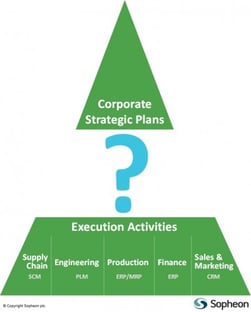Studies show that two-thirds to three-quarters of large organizations struggle to implement and execute their strategies. A Harvard Business Review article titled Why Strategy Execution Unravels—and What to Do About It provides good insights and guidance from research to understand how organizations can more effectively execute their corporate and business strategies. The article focuses on five widely held beliefs about implementing and executing strategy and closing the strategy execution gap that are proven to be wrong in the research.

These false beliefs or myths coincide very well with our experience for helping companies implement, consistently execute, and deliver exceptional performance from their innovation investments and initiatives. The following is a review of each of the myths identified by HBR in an innovation strategy and execution gap context.
Myth 1: Execution Equals Alignment
The research found that the vast majority of managers can depend on execution within their direct reporting teams, but only a very small minority can consistently rely on execution in other organizational functions and business units. That's no surprise to anyone who has attempted to implement enterprise-wide innovation management processes and a supporting software solution. Without cross-functional decision making, collaboration and execution processes and capabilities, strategic innovation initiatives will never deliver expected performance results. Additionally, you need processes and a supporting system to regularly manage execution on commitments, such as a Stage-Gate ®, Agile or other structured methodology.
Myth 2: Execution Means Sticking to the Plan
One of the universal truths we've probably all learned over the years is that once a plan is developed and rolled out, it will change. A great quote in the article is “no Gantt chart survives contact with reality.” We can all attest to that. That doesn't mean you don't need to plan because it will be wrong – not at all. What this means is that you need face reality in the implementation and execution of a plan. Circumstances change, new information comes out during the process, markets shift, resource deployments shift, investment funding priorities change, etc. You can't just blindly keep executing against the original plan. You have to adjust to the fluidity of the facts and real world as the implementation and execution proceed.
Myth 3: Communication Equals Understanding
Executives generally believe that the more they talk (preach) about organization strategies and business priorities, the better everyone in the organization will understand what to do and where to focus their attention. However, according to the study, a company's strategy is frequently poorly understood throughout the organization, regardless of how many times top level executives communicated it. The issue is about connecting the dots through the organizational levels. What it specifically means to each level of management and the people on their team. You can't assume that everyone can or will connect the high-level strategy with their daily tasks execution. That's a big gap in most organizations.
Myth 4: A Performance Culture Drives Execution
Most companies and managers focus on driving and rewarding performance. People will generally do whatever is required to deliver on their personal performance objectives to ensure they are rewarded with increases, promotions, incentives, etc. However, collaboration, particularly cross-functional collaboration is what matters most to drive execution of strategy. When last did you incentivize or reward people for good cross-functional collaboration?
Myth 5: Execution Should Be Driven from the Top
Only if you're a micro-manager, and that won't get you very far. Execution undoubtedly comes from the middle and lower levels of an organization. In large organizations, execution lives and dies with middle managers or “distributed leaders” according to the study. Concentration of power at the top inevitably slows down execution. Nobody makes a move unless the top person says so. All that talent and creativity in the organization is wasted waiting for the top executive(s) to make the next move. While execution can be guided from the top based on the strategy, it should be driven and owned by the middle managers or “distributed leaders” into their functional organizations.
The problem is that these false beliefs are pervasive in most organizations, and are not supportive of implementing enterprise-wide innovation management processes and systems that consistently produces outstanding results.
Close the Strategy Execution Gap
Interested in closing the strategy-execution gap? Read our webpage for insight into how software can help your organization realize strategy.
Stage-Gate® is a registered trademark of Stage-Gate Inc.




